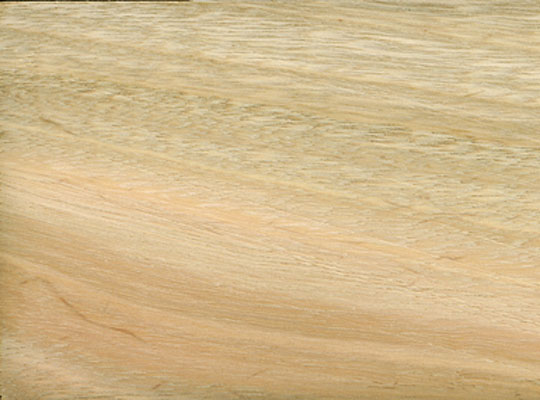Quilted Eucalyptus
The heartwood is pale yellow or pink, and is not clearly demarcated from the sapwood. The grain is usually straight, texture coarse. The density is 670–940 kg/m³ at 12% moisture content. The wood is difficult to dry without degrade, because it tends to check and warp, but proper stacking can reduce this tendency to a minimum. Strong collapse may occur, but reconditioning by steaming is possible. The rates of shrinkage from green to oven dry are high: 5.2–13.0% radial and 9.7–31.0% tangential.
The wood is tough, hard and moderately strong to strong. At 12% moisture content the modulus of rupture is (106–)140–183 N/mm², modulus of elasticity 11,500–17,800 N/mm², compression parallel to grain (47–)63–76 N/mm², shear 8–11 N/mm², cleavage 14–27 N/mm and Chalais-Meudon side hardness 6.0–7.8. Once dried, the wood is not stable in service.
The wood is fairly difficult to saw and plane, but African plantation trees give much better quality sawn wood than Australian native trees. Quartersawing is recommended. The wood may split on nailing and screwing, and pre-boring is recommended. The wood is not durable, being susceptible to attacks by termites and marine borers. The sapwood is susceptible to Lyctus borers. The heartwood is extremely resistant to impregnation with preservatives, the sapwood is permeable to moderately resistant.
Eucalyptus viminalis is considered to have potential to become more important as a source of pulp for paper making. Wood from 10-year-old trees from Australia had fibres 0.83 mm long, with a diameter of 20 μm. The wood contained 44% cellulose, 22% glucuronoxylan and 29% lignin. A bleached kraft pulp yield of 54% was obtained, with 3.8 m³ wood needed to obtain 1 t of bleached pulp. Compared to pulps from Eucalyptus globulus Labill. and Eucalyptus grandis W.Hill ex Maiden, which are currently the main sources of Eucalyptus pulpwood, pulp from Eucalyptus viminalis had a high strength, high opacity and low porosity, making it especially suited for wood free printing and writing papers and specialty papers.
In Ethiopia leaves yield 0.8% essential oil, with as main components 1,8-cineole (50.9%), α-pinene (28.2%), globulol (5.1%) and limonene (4.3%). The leaves of Brazilian trees contain 1.3–1.8% essential oil, with 1,8-cineole (84–87%) as main component. The essential oil content is highest in the summer season, when temperature and humidity are high.



